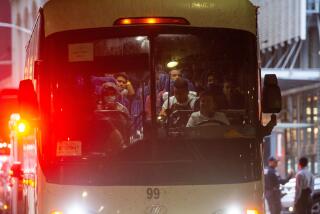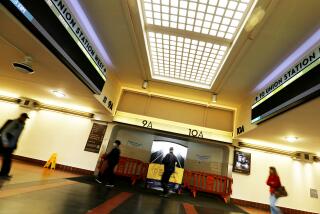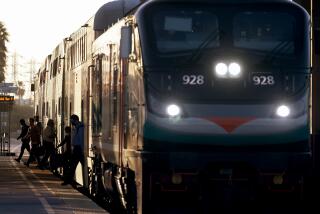No public transit in New York? Irene really is mean
Reporting from New York — They run through rain, snow and, unlike most systems, all hours through the gloom of night.
But it turns out that high winds and hammering downpours are too much for the largest transit system in the Western Hemisphere.
New York’s subways, trains and buses will shut down at noon Saturday for the expected hurricane many locals are calling “Mean Irene.”
Democratic Gov. Andrew Cuomo ordered the massive system closed to prevent flooding that would damage equipment and interfere with service, but especially to protect customers from being blown off platforms or hit by flying debris.
The region’s major bridges also will be closed if winds reach sustained speeds of 60 mph, but officials said they might close sooner if high winds are coupled with other weather-related problems, including flooding.
Jay Walder, chairman of the Metropolitan Transit Authority, said the system was so complex it would take eight hours to “turn it off.” Starting it up again might take longer and cut into Monday’s rush hour to repair tracks and clean out passages, he said.
Without their public wheels, many are likely to be at a loss, said Benjamin Kabak, a 28-year-old New Yorker who blogs about public transportation.
“I guess we’ll all just sort of hang around, stay home, in the neighborhood,” he said. “But I’m going to feel a little trapped.”
George Arzt, a veteran political observer, struggled to find the right superlative to capture New York without its public wheels.
“It’s the most bewildering, astonishing, fascinating thing I can imagine happening in New York City,” he said. “What happens when you pull the plug on a system everyone relies on? I can’t imagine.”
The only precedents are rare transit strikes, brief bouts of bad weather and blackouts; during a snowstorm in December, some subway and commuter trains didn’t run because of flooding and blocked tracks — and New Yorkers complained.
“Los Angeles had its failed ‘Carmageddon,’” said Max Long, who lives in Connecticut and commutes daily to a bank in Lower Manhattan. “New York out for a long period of time without transportation is the real thing — Armageddon.”
Indeed, mass transit is the lifeblood of the city — its subways, buses and commuter trains are the primary means of getting around for most New Yorkers.
On weekdays, the MTA accommodates 8 million riders, and on weekends about half that. The system operates 24 subway lines, 658 miles of track, 468 stations and 6,000 buses, in addition to the Brooklyn Battery and Queens Midtown tunnels, seven bridges and the Metro North, Long Island and Staten Island railroad lines.
“You know, it’s mind-boggling when you really think about it,” Arzt said. “I mean, all the methods of transportation being shut down — tunnels, bridges, buses, everything shut down and everyone in their houses. You can’t even go visiting or to a Broadway show, right?”
Indeed, the Broadway League canceled all performances Saturday and Sunday. Major sporting events also were rescheduled.
Kabak, whose blog is called SecondAvenueSagas.com, said he was intrigued by the notion of a brief period with no trains, screeching cars or ubiquitous blue-and-white city buses: “For a few hours, maybe days, that frenzied pace that everybody associates with New York will be taken away.”
PHOTOS: In the path of Hurricane Irene
More to Read
Sign up for Essential California
The most important California stories and recommendations in your inbox every morning.
You may occasionally receive promotional content from the Los Angeles Times.










